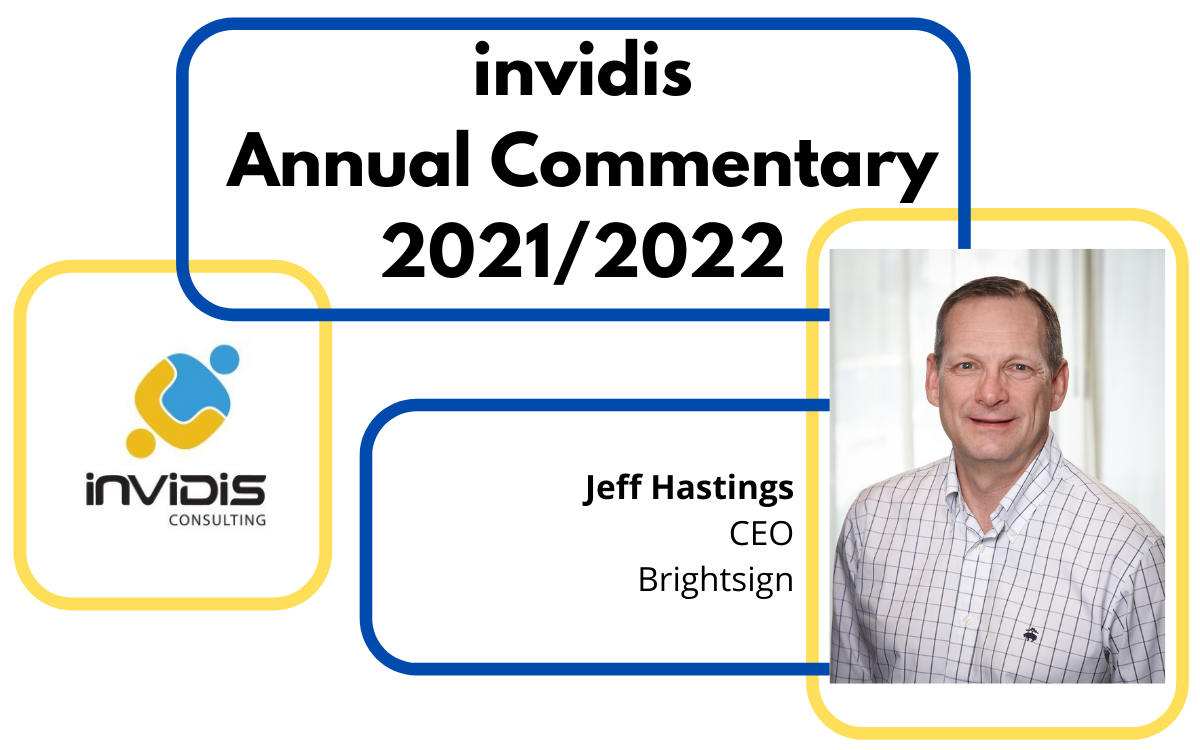Jeff Hastings, CEO of Brightsign, explains in the invidis Annual Commentary how digital signage has helped retail and public communications in particular to deal with the corona crisis.
There were winners and losers but overall, 2021 has been surprisingly good. Retailers whose business was classified as ‘essential’ experienced a boom during lockdown and were prepared to invest big and quickly in customer communications to maximise spend and improve the delivery of safety information. Covid-related lockdowns and restrictions gave other businesses the opportunity to refresh (or add new) digital signage to their businesses with minimal disruption. Additionally, many businesses and municipalities relied heavily on digital signage to effectively communicate new public health recommendations, social distancing requirements and general health and safety information as the pandemic evolved.
Brightsign shipped its’ two millionth player this year, a milestone we hit earlier than anticipated, thanks in part to growth catalysed by several pandemic-related influences. We also received the single-largest PO in our history right in the middle of lockdown. Although Covid challenged both us and our customers in many ways, the limiting factor on our growth this year was actually the shortage of silicon.
Our success this year was built on being able to adapt quickly. We have offered touchless interactivity for a long time, but interest in these solutions surged. We can eliminate the need to physically engage with touch-interactive digital signage, transferring control of the experience to customers’ phones by simply scanning a QR code. Other approaches included enabling interactivity via buttons and sensors that don’t require physical touch. For example, Audio Authority’s AirSelect Touchless Sensors easily integrate into existing displays and our players – which is great because then retailers don’t have to replace existing kiosk hardware. Heightened hygiene awareness is likely to stick around for a long time after the pandemic, so touchless digital displays are definitely here to stay.
I see the coming year as a year of opportunity for the industry. In 2021, digital signage pivoted rapidly from promotional and marketing messages to become a vehicle for communicating critically important health and safety messages to patrons, employees and the public at-large. This ability to swiftly and remotely update content has convinced many businesses that were still sticking with traditional signage to switch to digital. To capitalise, though, the industry as a whole needs to focus on ease-of-use and raising the bar for quality experiences and reliability. Lots of companies focus on new things but forget that the biggest problem in digital signage is blank screens or Windows “blue screens of death”.
Brightsign will evolve even more strongly and quickly in 2022 and continue to take the lead in providing the most powerful digital experiences for markets including retail, healthcare, education, attractions, stadiums, and transportation, among others. In terms of our focus, we believe that customers are not only looking for new capabilities, but also for us to make their current network of players easier to deploy and manage. This thinking is evident in the BSN.cloud updates we announced in December, which improve workflow in both areas as well as providing new functionality. Despite the parts shortages, Covidand other challenges, our customers can rely on BrightSign for new and market leading, best-in-class products in 2022.

